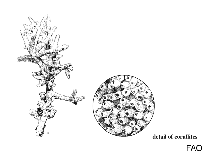Astreopora myriophthalma (Lamarck, 1816)
Porous star coralWarning: DOMDocument::load(): SSL operation failed with code 1. OpenSSL Error messages: error:140770FC:SSL routines:SSL23_GET_SERVER_HELLO:unknown protocol in C:\Apache24\htdocs\includes\SpeciesSummary.lib.php on line 1236
Warning: DOMDocument::load(): Failed to enable crypto in C:\Apache24\htdocs\includes\SpeciesSummary.lib.php on line 1236
Warning: DOMDocument::load(https://sealifebase.nrm.se/webservice/AquaMaps/getAMap.php?genus=Astreopora&species=myriophthalma): failed to open stream: operation failed in C:\Apache24\htdocs\includes\SpeciesSummary.lib.php on line 1236
Warning: DOMDocument::load(): I/O warning : failed to load external entity "https://sealifebase.nrm.se/webservice/AquaMaps/getAMap.php?genus=Astreopora&species=myriophthalma" in C:\Apache24\htdocs\includes\SpeciesSummary.lib.php on line 1236
Upload your photos
Google image | No image available for this species;
drawing shows typical species in Acroporidae.
Google image | No image available for this species;
drawing shows typical species in Acroporidae.
Classification / Names Common names | Synonyms | CoL | ITIS | WoRMS
| Scleractinia | Acroporidae
Environment: milieu / climate zone / depth range / distribution range Ekologi
Revassocierade; djupintervall 3 - 20 m (Ref. 98471). Tropical; 35°N - 30°S, 32°E - 108°W (Ref. 846)
Utbredning Länder | FAO områden | Ekosystem | Förekomster | Utplanteringar
Indo-Pacific. Tropical to subtropical.
Length at first maturity / Size / Vikt / Age
Maturity: Lm ? range ? - ? cm
Most reef habitats except turbid water (Ref. 846). Carries dense populations of the bivalve L. simplex. Bivalves are completely enclosed by the skeleton. They benefit from the coral through nutrition and protection against predators. The coral's gain, however, is unclear (Ref. 115168).
Life cycle and mating behavior Könsmognad | Reproduktion | Lek | Ägg | Fecundity | Larver
Hermaphroditic (Refs. 113708, 113712). Mature gametes are shed into the coelenteron and spawned through the mouth. Life cycle: The zygote develops into a planktonic planula larva. Metamorphosis begins with early morphogenesis of tentacles, septa and pharynx before larval settlement on the aboral end (Ref. 833).
Main reference
referenser | Koordinator | Medarbetare
Veron, J.E.N. 2000. (Ref. 846)
IUCN Red List Status (Ref. 130435)
Least Concern (LC) ; Date assessed: 03 January 2008
CITES status (Ref. 108899)
Appendix II: International trade monitored
CMS (Ref. 116361)
Not Evaluated
Threat to humans
Human uses
| FishSource |
Verktyg
Ytterligare information
Internet-källor
BHL | BOLD Systems | CISTI | DiscoverLife | FAO(Publication : search) | Fishipedia | GenBank (genome, nucleotide) | GloBI | Gomexsi | Google Books | Google Scholar | Google | PubMed | Hexacorallians of the World | Tree of Life | Wikipedia (Go, sök) | Zoological Record
Estimates based on models
Preferred temperature
(Ref. 115969): 25 - 29.3, mean 28.4 (based on 3492 cells).
Price category
(Ref. 80766):
Unknown.



